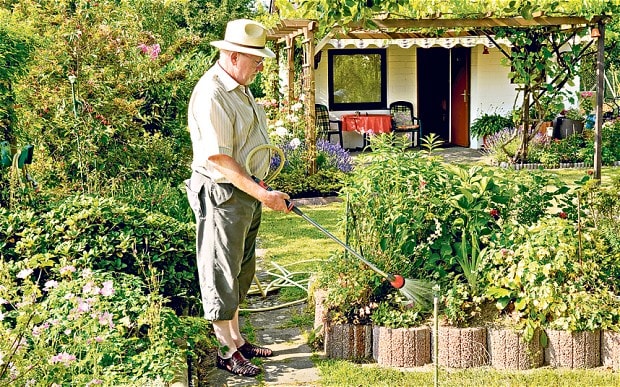There are a couple of vegetable gardens on Pottendorf, examples of the Schrebergärten movement started by Daniel Gottlob Moritz Schreber (15 October 1808 – 10 November 1861) His publications predominantly dealt with the subject of children's health and the social consequences of urbanization at the dawn of the Industrial Revolution. Schreber was the founder of the eponymous "Schreber movement". In 1864, the first Schrebergärten , was established by leasing land for the physical exercise of children.
Move forward 150+ years and you're zipping along in an ICE high-speed
train, munching happily away on your bratwurst , just as you're wiping
the last blob of mustard from the corner of your mouth, a lazy glance
out the window, though, comes as a shock. Rather than the well-ordered
suburbs or well-kept factories you have come to expect- miniature houses
tucked in next to the train tracks as far as the eye can see.
It's a sight that greets visitors on the approach to almost every town
in Germany -- the clutter of ladders and rakes leaning against the back
of the structures, neatly ordered flowerbeds, well-tended fruit trees
and picture-perfect picket fences are lined up like regiments of tin
soldiers. The phenomenon is known as a Schrebergärten -- an area outside
the city where the gardening-obsessed Germans can rent out a small plot
and plunge their fingers into the soil.
Ordered, trimmed, enclosed, ornamental, each strip has some kind of glorified shed with floral and vegetable displays. As for people, they’re only temporary visitors, because however fabulous the summerhouse/cottage/shed – and some are very fancy –one of the many hundreds of rules is that a Schrebergärten is strictly non-residential and rules are there to be obeyed. These enclosures are the garden equivalent of white bread: nature with the wildness extracted – and with more fertilizer per square metre than any farmer would dare to use.
I like creating Schrebergärten, mine are largely Busch, Noch and scratch, they include strawberries, green and red cabbage, cauliflower, green and red lettuce. Over the next couple of weeks, I would like to share the creation of a Schrebergärten for Pottendorf.
The small garden is part of the farmhouse, the original was at least 14 years old and used on at least two previous layouts. It has been extended to include the farmhouse and the long grass was looking rather threadbare. There is some further work needed, the washing line will be given some clothes.
In addition to the
farmhouse and cottage there is the station staff's allotment near the
bufferstop. As yet, just a patch of furrowed soil, it does have a
potting/tool shed which as yet to be ‘planted’.
However, there is a rural reality of cultivating vegetables, certainly not the ‘pretty’ cottage garden.









No comments:
Post a Comment
Spam and anonymous comments never get published but it does make me laugh!
And whilst your reading this, everything I post is subject to copyright.